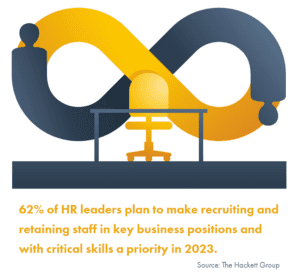By changing workforce management approaches, people leaders can successfully navigate an evolving candidate market.
By Melissa Dreuth
After years of recruiters having the edge in the jobs market, there’s been an evolution. Job creation numbers are uncommonly strong, and there are subtle shifts in the market indicating that candidates seeking employment might have the upper hand. While that may be the case, there are seeming contradictions, such as large tech companies shedding workers while certain tech positions remain hard to fill.
In general, top talent now has more pull when it comes to demanding benefits and landing at a company that meets their expectations, rather than sticking it out with employers they are unhappy with. This new environment requires a workforce management strategy adjustment for hiring managers.
People leaders can take this opportunity to reinforce standards and ensure that hiring criteria are met. And now is the time to work closely with hiring managers to set expectations and make sure the applicant experience remains positive. There are a few approaches that can help transform workforce management in order to stay agile.
Find the Best People and Connect with Them
Hiring the best, most qualified people is the ultimate objective in recruiting, so it makes sense to cast the widest net possible into the talent pool. People leaders should consider looking beyond candidates who are actively seeking a new role, and instead, start conversations with passive candidates who are not looking now but may be ready to make a career move in the future. This is a great way to keep the company top-of-mind.
For all potential hires—from passive candidates to those who are actively looking—it’s critical to create a great experience, and that starts with clear, timely communication. Recruitment is a lot like dating: You’ll want to stay in touch throughout the process and make a great impression. So, make sure the company’s merits are sold with a polished website that highlights employee perks and benefits, growth statistics, and company accomplishments.
Take Care of Your People, Wherever They Are
This is also the right time for people leaders to forget everything they thought they knew about hiring since circumstances have changed dramatically. The best people might not live near the company’s offices; they might be on the opposite end of the continent or halfway around the world. If remote work is possible, consider starting a small hiring initiative in locations not previously considered, then evaluate results and expand it if it works.
To attract and retain the best people, HR should implement programs that address the needs of the whole employee. This can include rapid-response initiatives to support employees and their families when they need help urgently. For example, after a hurricane hit Florida, Planful reached out to impacted employees and offered assistance in finding alternate housing. Also, making changes, like expanding parental leave and the benefits associated with it, or offering programs that assist families when employees have to travel for work, makes teams feel supported beyond the 9-5.
Employees remember what companies did not just in the good times but in the trying and stressful times, too.

Use Technology to Streamline Processes and Create Value
HR’s tech stack can play a significant role in keeping pace with an evolving talent market. Adopting technology that helps automate manual processes and streamline routine people management tasks frees the team to focus on more mission-critical work and collaborate across business units. But that’s just the beginning. People management technology can add value to the business in a myriad of ways.
Frontline managers typically have more influence on whether employees stay with a company or seek opportunities elsewhere, so it’s a good idea to give managers a technology toolkit to help them consistently execute tasks. Also, consider sharing the metrics and statistics generated across the entire people management tech stack, including data on employee engagement, candidate feedback from interview processes, and other impactful information that can improve results and boost morale.
Make Deposits in the Company Culture ATM
As the industry has seen over the past few years, business conditions can change practically overnight, and people leaders need to be ready to align the workforce with evolving company needs—even as the labor market is changing at the same time. The target is always moving, so it is important to be prepared for any contingency, which takes new levels of agility and creativity.
It also requires a reservoir of goodwill among employees, managers, executives, and the larger community. A strong company culture can make a huge difference, and just like any other resource, it needs to be maintained over time. It’s helpful to think of company culture as an ATM. If frequent, regular deposits are made—no matter how big or how small—when it comes time to make a withdrawal, the impact will be lessened.
The past isn’t predictive, so techniques that worked previously may not be the best fit today. That means, now is a great time for recruiters to look at the talent pool with a wider lens, get creative with benefits, and use technology in new ways, recognizing that data is a critical element in telling a company’s story. By changing the approach, people leaders can successfully navigate an evolving candidate market.
Melissa Dreuth is the chief people officer and chief of staff to the CEO at Planful.














